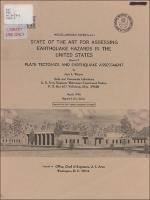Please use this identifier to cite or link to this item:
https://hdl.handle.net/11681/20891| Title: | State of the art for assessing earthquake hazards in the United States. Report 5, Plate tectonics and earthquake assessment |
| Authors: | Walper, Jack L. |
| Keywords: | Earthquakes Earthquake risk Earthquake hazards United States Plate tectonics State-of-the-art studies Seismology Geology |
| Publisher: | Soils and Pavements Laboratory (U.S.) Engineer Research and Development Center (U.S.) |
| Description: | Miscellaneous Paper Abstract: The emerging theory of plate tectonics, embodying continental drift, sea floor spreading, transform faults, subduction of lithospheric plates, and other basic tenets, provides earth scientists with a reasonably coherent and workable explanation of the occurrence and distribution of earthquakes. It explains the tectonic origin of belts of major seismic activity throughout the United States and provides a consistent pattern into which focal mechanisms of major earthquakes can be fitted. It provides a framework into which a wide variety of observations of geology and geophysics can be assimilated. In short, it is a unifying concept long sought by earth scientists. In this report, plate boundary regimes are examined and the variable factors influencing plate interaction and earthquake generation are evaluated. These findings are applied to various boundary regimes found along the west coast of the United States. The geologic history of the United States, interpreted in terms of plate tectonics, is outlined to emphasize that crustal structures currently active in producing earthquakes had their origin long ago in episodes of continental rifting and collision. The processes of orogeny and epeirogeny are examined in terms of earthquake generation. Orogeny, in terms of plate tectonics, is produced by plate convergence, the formation of volcanic arcs, and finally plate collision, whereas epeirogeny appears to be the result of mantle configuration or the product of mantle motion. Both processes have been active throughout geologic time and are currently active as producers of seismicity. Earlier orogenic episodes have formed the crust of the western United States and have left it different from that of the eastern United States. The seismicity of the United States is reviewed and related to plate tectonic phenomena currently active and to contemporary stress fields. Evidence indicates that seismicity of the western United States is the product of the interaction between the Pacific and North America plates (as a result of transform and convergent boundary regimes along the west coast) and the interaction of subplates within the western interior, the latter interaction having been mobilized by mantle plumes overridden by the North America plate. Although the present understanding of plate tectonics has provided a framework into which a wide variety of geological and geophysical observations can be fitted, plate tectonic theory is still being formulated and it is not completely understood. There are many gaps not only in the present state of knowledge of the driving mechanism but also in the knowledge of the stress conditions prevailing in the crust of the United States and how this stress is released in the form of earthquakes by plate motion. |
| Rights: | Approved for public release; distribution is unlimited. |
| URI: | http://hdl.handle.net/11681/20891 |
| Appears in Collections: | Miscellaneous Paper |
Files in This Item:
| File | Description | Size | Format | |
|---|---|---|---|---|
| MP-S-73-1-Report-5.pdf | 13.52 MB | Adobe PDF |  View/Open |